In modern agriculture and garden maintenance, choosing an efficient and reliable lawn mowing equipment is crucial for improving work efficiency and ensuring work quality. As an advanced piece of mechanical equipment, the hydraulic scythe mower is becoming the preferred choice of farmers and gardeners due to its unique features and advantages. So, what are the outstanding features of this mower? How do its technical parameters meet different operational needs? What are the key things to pay attention to in the process of using it? These are the questions that farmers need to know before using a mower.
With its high efficiency, convenience, adaptability and easy maintenance, the hydraulic sickle mower can effectively improve operational efficiency and reduce operating costs, making it an ideal tool in modern agriculture and garden maintenance. Its hydraulic system can provide strong power, and allows the operator to quickly and easily adjust the height and angle of the cutter, can enhance operational flexibility; sickle cutter can ensure a flat cut stubble, improve the aesthetics and quality of the lawn or pasture; hydraulic system maintenance is relatively simple, can extend the service life of the system and to ensure the stability of the system,In addition, compared to manual mowing, hydraulic mowers can significantly reduce mowing costs.
In the following sections, we will delve deeper into the various features of the hydraulic sickle bar mower, helping you fully understand and effectively utilize this efficient tool.
Contents
- 1 Hydraulic Sickle Mower Overview
- 2 Advantages of hydraulic scythe mowers
- 3 Stability of the hydraulic system and possible problems after long-term use
- 4 Hydraulic scythe mowers are suitable for harvesting the following types of forage and crops
- 5 Hydraulic sickle mower power requirements for tractor or other towing equipment
- 6 Hydraulic Sickle Mower Repair and Maintenance
- 7 The advantages of hydraulic mowers in greening the environment
- 8 Recommendations for novice operators of hydraulic scythe mowers
- 9 Conclusion
Hydraulic Sickle Mower Overview
A hydraulic sickle bar mower is a mechanical device designed for trimming lawns or forage crops by utilizing a hydraulically driven sickle cutter bar. Its fundamental operation involves converting the mechanical energy generated by the engine into hydraulic energy, which then drives the cutter bar in a reciprocating motion to efficiently cut grass or forage.
Key Components and Their Functions:
Engine: Serves as the primary power source for the entire machine, typically an internal combustion engine.
Hydraulic System: Comprises components such as the hydraulic pump, hydraulic cylinders, and control valves. This system transforms the engine’s mechanical energy into hydraulic energy, governing the movement of the cutter bar.
Cutter Bar (Sickle): Consists of moving and stationary blades; the moving blade, driven by the hydraulic system, oscillates relative to the stationary blade to achieve the cutting action.
Travel Mechanism: Includes wheels and transmission components that facilitate the movement of the equipment within the working area.
Control System: Made up of levers and control valves, allowing the operator to manage the actions of both the cutter bar and the movement of the machine.
Frame: Provides structural support, housing all the aforementioned components securely.
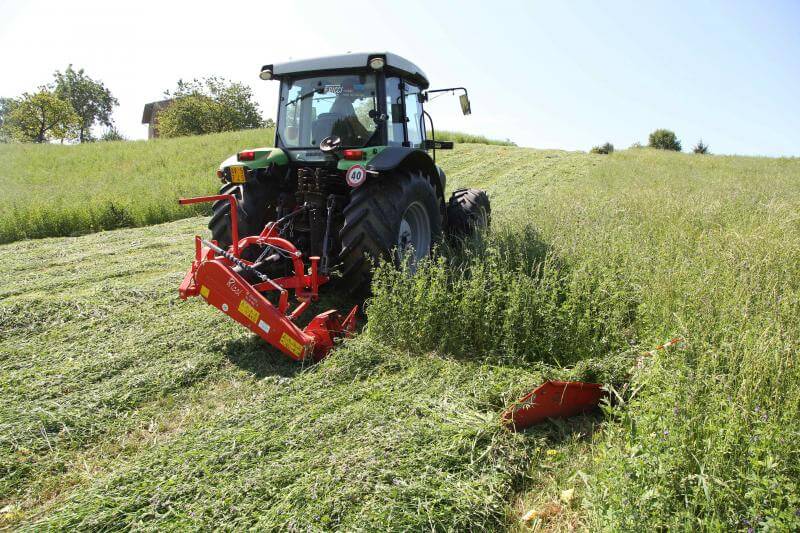
Advantages of hydraulic scythe mowers
Hydraulic sickle bar mowers offer several distinct advantages in agricultural and landscaping applications:
Enhanced Efficiency: The hydraulic system delivers consistent and robust power, enabling the cutter bar to operate swiftly and continuously, thereby significantly boosting mowing efficiency.
User-Friendly Operation: Hydraulic controls allow operators to effortlessly adjust the cutter bar’s height and angle, accommodating various terrains and grass types. This adaptability not only enhances operational flexibility but also reduces physical labor.
Clean and Precise Cuts: The sickle bar cutter ensures a uniform and tidy cut, enhancing the aesthetic appeal and quality of lawns and pastures.
Versatility: These mowers are suitable for a range of environments, including flat natural grasslands and moderately yielding artificial pastures, consistently delivering optimal performance across diverse conditions.
Simplified Maintenance: Hydraulic systems are generally easier to maintain compared to mechanical alternatives. Regular tasks such as replacing hydraulic fluid, cleaning components, and inspecting seals can extend the system’s lifespan and ensure reliable operation.
Performance Comparison:
Daily Mowing Capacity: While specific coverage can vary based on mower specifications and field conditions, hydraulic sickle bar mowers are designed to handle extensive areas efficiently, often surpassing the capabilities of manual methods.
Efficiency Relative to Manual Methods: By mechanizing the mowing process, these mowers can achieve significantly higher productivity compared to manual mowing, reducing time and labor costs.
In summary, hydraulic sickle bar mowers provide a combination of efficiency, ease of use, precision, adaptability, and straightforward maintenance, making them a valuable asset for modern agricultural and landscaping operations.
Here’s a comprehensive comparison of various lawn mower types, detailing their cutting styles, terrain adaptability, power requirements, maintenance needs, and affordability:
| Type | Cutting Style | Terrain Adaptability | Power Requirements (HP) | Maintenance Needs | Affordability |
| Manual Reel Mower | Human-powered blades that rotate to provide a scissor-like cut, ideal for precise trimming. | Best suited for flat, small lawns; requires smooth terrain. | None; entirely manual. | Simple maintenance; regular blade cleaning and sharpening needed. | Very affordable; ideal for budget-conscious users. |
| Hydraulic Sickle Bar Mower | Utilizes a hydraulically driven sickle bar for reciprocating cutting action. | Versatile; handles various terrains, including uneven areas. | Requires a hydraulic power source, typically from a tractor. | Regular checks of the hydraulic system and blades; relatively straightforward upkeep. | Higher cost; designed for professional agricultural use. |
| Gas-Powered Rotary Mower | Engine-driven horizontal rotating blades for efficient cutting over large areas. | Suitable for diverse terrains; powerful and adaptable. | Varies widely; generally requires a gas engine. | Regular engine maintenance, including oil changes and air filter cleaning; higher upkeep. | Moderately priced; fuel costs should be considered. |
| Electric Rotary Mower | Electric motor drives rotating blades; offers clean cuts with lower noise. | Ideal for flat or mildly uneven medium-sized lawns. | Depends on motor; typically lower power compared to gas models. | Minimal maintenance; focus on battery care or cord management. | Moderately priced; lower long-term operating costs. |
| Cylinder (Reel) Mower | Uses a helical blade assembly for scissor-like cutting; delivers a fine, even cut. | Best for flat, well-maintained lawns requiring a high-quality finish. | Varies; can be manual or engine-powered. | Requires regular blade adjustment and sharpening; maintenance can be meticulous. | Price varies based on propulsion method and size. |
| Rotary Mower | High-speed horizontal rotating blades suitable for general lawn maintenance. | Works well on flat to slightly uneven terrains. | Requires moderate engine power, typically between 5-10 HP. | Routine blade inspection and engine servicing necessary. | Moderately priced; suitable for small to medium lawns. |
| Flail Mower | Features free-swinging blades (flails) that pulverize tough vegetation; ideal for heavy-duty tasks. | Excels in rough, overgrown, and uneven terrains. | Demands higher engine power, usually between 10-20 HP. | Regular inspection of flails and drivetrain; maintenance can be intensive. | Higher cost; intended for professional or large-scale use. |
| Hammer Knife Mower | Utilizes “L”-shaped hammer knives for shredding thick brush and vegetation. | Designed for challenging, rugged terrains. | Requires substantial engine power, often between 15-25 HP. | Frequent checks of knives and transmission; maintenance is more complex. | Higher price point; tailored for specialized applications. |
| Tow-Behind Mower | Attached to and pulled by a vehicle; covers extensive areas efficiently. | Best suited for large, open, and relatively flat areas. | Depends on towing vehicle; generally needs 20+ HP. | Maintenance focuses on hitch mechanism and blades; relatively simple. | Cost varies with size and features; ideal for expansive properties. |
| Push Mower | Operator pushes the mower; blades rotate to cut grass. | Suitable for small, flat lawns. | Manual or low-power electric; minimal HP needed. | Easy maintenance; regular blade cleaning and occasional sharpening. | Low cost; perfect for small-scale residential use. |
| Riding Lawn Mower | Operator rides on the mower; covers large areas with ease. | Ideal for expansive, flat to gently rolling lawns. | Requires moderate to high engine power, typically 15-25 HP. | Regular engine, transmission, and blade maintenance; more involved upkeep. | Higher investment; suited for large properties or professional use. |
Note: The specifications provided are general guidelines. Specific models may vary in features and requirements. It’s essential to consult manufacturer details and consider individual needs when selecting a mower.
Stability of the hydraulic system and possible problems after long-term use
Hydraulic systems are integral to industrial equipment, with their stability directly impacting performance and longevity. Over prolonged use, issues such as leaks or insufficient pressure may arise. Below are common causes and their respective solutions:
1. Aging or Damaged Seals
Seals are crucial in preventing fluid leaks within hydraulic systems. Over time, they can deteriorate due to material aging, wear, or improper installation, leading to leakage.
Solutions:
Conduct regular inspections and replace seals as needed, ensuring they meet system specifications.
During installation, verify that seals are correctly positioned to avoid damage.
2. Hydraulic Fluid Contamination
Impurities, particles, or moisture in hydraulic fluid can accelerate component wear, resulting in leaks and pressure deficiencies.
Solutions:
Maintain fluid cleanliness by routinely filtering or replacing it.
Prevent contaminants from entering during maintenance or refilling.
3. Incorrect System Pressure Settings
Improper pressure settings can damage components or cause leaks.
Solutions:
Set system pressure according to equipment specifications to avoid extremes.
Install pressure gauges for real-time monitoring and timely adjustments.
4. Elevated Hydraulic Fluid Temperature
High temperatures reduce fluid viscosity, increasing leak risks and accelerating seal degradation.
Solutions:
Ensure adequate system cooling; add cooling devices if necessary.
Avoid prolonged high-load operations and regularly monitor fluid temperature.
5. Component Wear or Manufacturing Defects
Wear or defects in pumps, valves, and other components can cause internal leaks, affecting system pressure.
Solutions:
Regularly inspect critical components for wear; repair or replace as needed.
Choose high-quality components to ensure manufacturing precision and assembly quality.
6. Loose or Damaged Pipeline Connections
Loose fittings or damaged pipelines can lead to external leaks, compromising system pressure.
Solutions:
Periodically check pipeline connections for secure fastening.
Promptly repair or replace damaged pipelines.
Preventive Measures Summary:
Regular Maintenance: Develop and adhere to a maintenance schedule, routinely inspecting and servicing all hydraulic system components.
Operator Training: Ensure operators are knowledgeable about hydraulic systems for proper operation and maintenance.
Use of Quality Components and Fluids: Select high-quality seals, hydraulic fluids, and other components to enhance system reliability.
Implementing these strategies can effectively mitigate hydraulic system issues, ensuring stable and efficient equipment operation.

Hydraulic scythe mowers are suitable for harvesting the following types of forage and crops
Hydraulic sickle bar mowers are highly effective for cutting various types of vegetation, including:
Natural Grasses: Such as alfalfa and ryegrass.
Cultivated Forage Crops: Including oats and sudangrass.
Crop Residues: Like corn stalks, rice straw, and wheat straw.
These mowers utilize a reciprocating blade mechanism driven by a hydraulic system, ensuring clean and efficient cuts in these softer plant materials.
However, when dealing with tougher, more fibrous vegetation—such as brush, thick-stemmed weeds, or woody plants—hydraulic sickle bar mowers may not perform as efficiently. In these scenarios, flail mowers are often more suitable. Designed to handle denser vegetation, flail mowers can effectively shred brush and woody plants up to approximately 2 inches (5 cm) in diameter, making them ideal for use in forests, roadsides, and areas with dense undergrowth.
Therefore, selecting the appropriate mower should be based on the specific type of vegetation and operational requirements. For softer grasses and crop residues, hydraulic sickle bar mowers offer excellent performance. Conversely, for tougher, more fibrous vegetation, flail mowers provide enhanced efficiency and effectiveness.
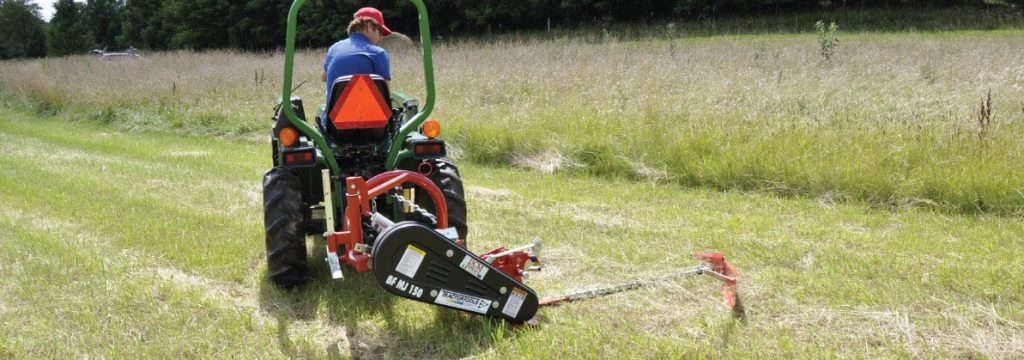
Hydraulic sickle mower power requirements for tractor or other towing equipment
When considering the integration of a hydraulic sickle bar mower with your tractor, it’s essential to evaluate several compatibility factors to ensure optimal performance and safety.
1. Power Compatibility:
Hydraulic sickle bar mowers require a specific range of tractor horsepower (HP) to operate efficiently. For instance, certain models are designed for tractors with power outputs ranging from 12 to 35 HP, while others may necessitate higher horsepower. It’s crucial to verify that your tractor’s HP aligns with the mower’s requirements.
2. Power Take-Off (PTO) Specifications:
The mower’s operation relies on the tractor’s PTO system. Ensure that your tractor features a standard 540 RPM PTO, as this is commonly required for many sickle bar mowers. Additionally, confirm that the PTO shaft’s spline count and size are compatible with the mower’s input specifications.
3. Three-Point Hitch Compatibility:
Most hydraulic sickle bar mowers are designed to attach via a Category I or II three-point hitch system. Verify that your tractor’s hitch category matches the mower’s mounting requirements to facilitate proper attachment and operation.
4. Hydraulic System Requirements:
If the mower utilizes hydraulic functions, such as lifting mechanisms, ensure that your tractor is equipped with the necessary hydraulic outlets and that its hydraulic system can deliver the required flow and pressure. Some mowers may require a single-action hydraulic cylinder, necessitating at least one hydraulic remote on the tractor.
Recommendations:
Consult Manufacturer Guidelines: Always refer to both your tractor’s and the mower’s manuals for specific compatibility information and operational guidelines.
Seek Expert Advice: If uncertainties persist regarding compatibility, consult with the mower’s manufacturer or an authorized dealer. They can provide detailed insights and may suggest necessary adjustments or accessories to ensure a seamless integration.
By meticulously assessing these factors, you can ensure that your tractor and hydraulic sickle bar mower function cohesively, leading to efficient and safe mowing operations.
When selecting a mower compatible with your tractor’s horsepower (HP), it’s essential to match the implement’s specifications to your tractor’s capabilities to ensure optimal performance and safety. Below is a general guide to assist you in making an informed decision:
| Tractor Horsepower Range (HP) | Suitable Mower Types | Mower Working Width (meters) | Remarks |
| 15-25 HP | Light-Duty Flail Mower Small Rotary Mower | 1.0 – 1.5 | Ideal for small farms or orchards; suitable for trimming lawns, light weeds, and small shrubs. |
| 25-50 HP | Medium-Duty Flail Mower Medium Rotary Mower | 1.5 – 2.0 | Suitable for medium-sized farms; capable of handling thicker weeds and moderately dense shrubs. |
| 50-75 HP | Heavy-Duty Flail Mower Large Rotary Mower | 2.0 – 2.5 | Appropriate for large farms or pastures; efficiently manages dense weeds and thicker shrubs. |
| 75-100 HP | Heavy-Duty Flail Mower Large Rotary Mower | 2.5 – 3.0 | Suitable for extensive farmland or pastures; capable of quickly processing high-density vegetation, enhancing operational efficiency. |
| 100+ HP | Extra Heavy-Duty Flail Mower Large Rotary Mower | 3.0 and above | Designed for very large farms or professional operations; handles the densest and heaviest vegetation, meeting high-intensity operational demands. |
Key Considerations:
Tractor Specifications: Ensure your tractor’s power take-off (PTO) horsepower aligns with the mower’s requirements. Mower manufacturers typically specify the necessary PTO horsepower for each model.
Mower Weight and Size: Verify that your tractor’s weight and size can safely handle the mower’s dimensions and mass, maintaining stability during operation.
Terrain and Vegetation: Assess the type of terrain and vegetation you’ll be managing. Heavier-duty mowers are better suited for rough terrains and denser vegetation.
Manufacturer Recommendations: Always consult your tractor and mower manufacturers’ guidelines to ensure compatibility and safe operation.
Hydraulic System Requirements: Some mowers may require hydraulic support from the tractor, verify that the tractor’s hydraulic system meets the mower’s needs.
By carefully evaluating these factors, you can select a mower that complements your tractor’s capabilities, ensuring efficient and safe mowing operations.
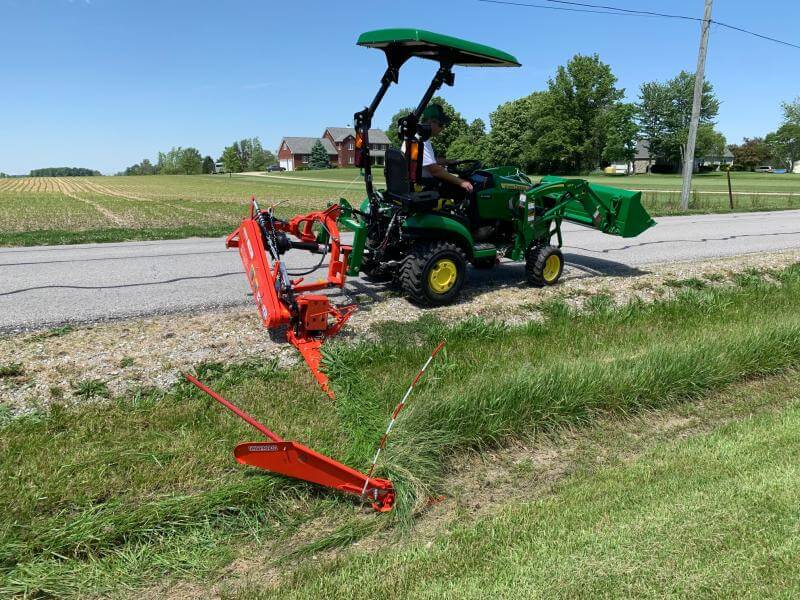
Hydraulic Sickle Mower Repair and Maintenance
Proper maintenance of your hydraulic sickle bar mower is crucial for ensuring its longevity and optimal performance. Below is a comprehensive guide detailing the recommended maintenance tasks and their frequencies:
Daily Maintenance:
1.Cleaning the Equipment:
After each use, remove grass clippings, soil, and debris from the mower to prevent blockages and corrosion.
2.Inspecting Fasteners:
Ensure all bolts and nuts are securely tightened to prevent operational issues caused by loose components.
Periodic Maintenance:
1.Lubrication of Moving Parts:
Lubricate grease fittings every 2 working hours to minimize wear on components.
2.Power Take-Off (PTO) Shaft Maintenance:
Lubricate the PTO shaft cross journal every 8 working hours to ensure smooth power transmission.
3.Belt Tension Check:
Inspect and adjust belt tension every 8 working hours to maintain efficient power transfer.
4.Bolt Tightness Inspection:
Every 50 working hours, verify that all bolts, especially those on the blade movement support, are properly tightened.
5.Hydraulic System Check:
Regularly monitor hydraulic oil levels and cleanliness, replacing the oil and filters as needed to ensure optimal system performance.
6.Blade Maintenance:
Sharpen or replace mower blades every 20-25 hours of use to maintain effective cutting performance.
Maintenance Costs:
Maintenance expenses can vary based on the mower model, usage intensity, and adherence to maintenance schedules. Regular preventive maintenance can reduce the likelihood of unexpected repairs and associated costs. Common maintenance expenses include:
1.Blade Replacement:
Blades are wear-prone components; timely replacement ensures efficient cutting. Costs depend on blade type and quality.
2.Hydraulic System Maintenance:
Expenses may involve hydraulic oil and filter replacements, as well as potential repairs to pumps or valves.
3.Other Component Repairs or Replacements:
Parts such as bearings and belts may require attention based on wear and operational conditions.
Maintenance Recommendations:
1.Develop a Maintenance Schedule:
Create a maintenance plan tailored to your mower’s usage frequency and operating environment to keep it in optimal condition.
2.Train Operators:
Ensure operators are well-versed in the mower’s operation and maintenance procedures to promptly identify and address potential issues.
3.Use Genuine Parts:
Opt for original manufacturer parts or high-quality alternatives during replacements to maintain performance and extend equipment lifespan.
4.Maintain Detailed Records:
Keep logs of all maintenance and repair activities to monitor equipment condition and proactively address potential concerns.
Adhering to these maintenance practices will help ensure that your hydraulic sickle bar mower operates efficiently and remains reliable over time.
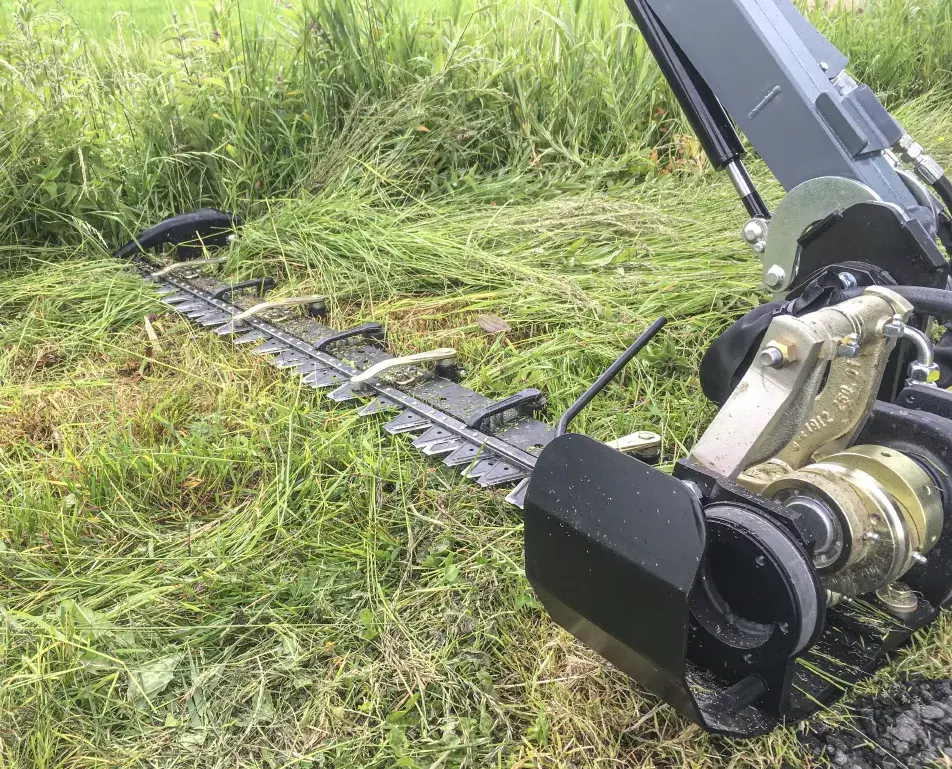
The advantages of hydraulic mowers in greening the environment
Hydraulic lawn mowers offer several environmental advantages that contribute to more sustainable and eco-friendly landscaping practices:
1. Energy Efficiency:
Hydraulic systems are renowned for their high power density and efficient energy transmission. This efficiency can lead to reduced fuel consumption and lower carbon emissions compared to less efficient mechanical systems.
2. Noise Reduction:
Hydraulic mowers typically operate more quietly than their gas-powered counterparts. The smoother operation of hydraulic systems contributes to a reduction in noise pollution, creating a more pleasant environment for both operators and surrounding communities.
3. Minimized Risk of Fluid Leaks:
Modern hydraulic systems utilize high-quality seals and precision engineering to reduce the likelihood of fluid leaks. Preventing hydraulic fluid leaks is crucial, as such leaks can lead to soil and water contamination, posing environmental hazards.
Comparative Environmental Benefits:
Versus Gas-Powered Mowers:
Traditional gas-powered mowers emit significant amounts of pollutants, including carbon monoxide, hydrocarbons, and nitrogen oxides, contributing to air pollution and greenhouse gas emissions. Hydraulic mowers, with their efficient energy use, can reduce fuel consumption and associated emissions. Additionally, their quieter operation decreases noise pollution, which is beneficial for both users and the environment.
Versus Electric Mowers:
While electric mowers produce zero emissions during operation, their environmental impact is influenced by the source of the electricity used to charge them. If the electricity comes from fossil fuels, the overall environmental benefits may be diminished. Hydraulic mowers, by optimizing fuel efficiency and reducing emissions, offer a consistent environmental advantage regardless of the energy grid’s composition.
In summary, hydraulic lawn mowers present notable environmental benefits, including enhanced energy efficiency, reduced noise pollution, and a lower risk of environmental contamination from fluid leaks. These attributes make them a compelling choice for eco-conscious landscaping professionals and homeowners aiming to minimize their environmental footprint.

Recommendations for novice operators of hydraulic scythe mowers
Hydraulic sickle bar mowers are engineered with user-friendly features to facilitate straightforward operation. However, for individuals new to this equipment, it’s essential to focus on several key areas to ensure both safety and efficiency:
Operational Considerations for New Users:
1.Basic Operation:
The fundamental functions of starting, maneuvering, and mowing with a hydraulic sickle bar mower are designed to be intuitive. New users should thoroughly review the manufacturer’s operating manual to become acquainted with these basic procedures.
2.Understanding the Hydraulic System:
Given that the mower operates using a hydraulic system, it’s crucial for new operators to grasp the basic principles and functionalities of hydraulics. This knowledge ensures the equipment is used safely and effectively.
3.Emphasizing Safety:
The mower’s blades move at high speeds during operation, presenting potential hazards. Adhering strictly to safety protocols is imperative to prevent accidents. This includes maintaining a safe distance from the blades and ensuring all safety guards are in place.
Recommended Training for New Operators:
1.Operational Training:
Engage in training sessions provided by the manufacturer or authorized dealers. These sessions typically cover essential aspects such as equipment startup, operation, and shutdown procedures.
2.Safety Training:
Participate in comprehensive safety training that addresses proper use of personal protective equipment (PPE), identification of potential hazards, and emergency response strategies.
3.Maintenance Training:
Learn the routine maintenance tasks necessary to keep the mower in optimal working condition. This includes understanding lubrication points, belt adjustments, and blade sharpening techniques.
Additional Recommendations:
1.Seek Professional Guidance:
Consult with equipment suppliers or certified trainers to gain professional insights and hands-on instruction, ensuring the mower is used correctly and safely.
2.Hands-On Practice:
Under the supervision of experienced personnel, engage in practical operation of the mower to build confidence and competence.
3.Adhere to Safety Guidelines:
Consistently follow the safety instructions outlined in the operator’s manual, including the use of appropriate PPE and adherence to operational limits.
By focusing on these areas, new users can effectively learn to operate hydraulic sickle bar mowers safely and efficiently.
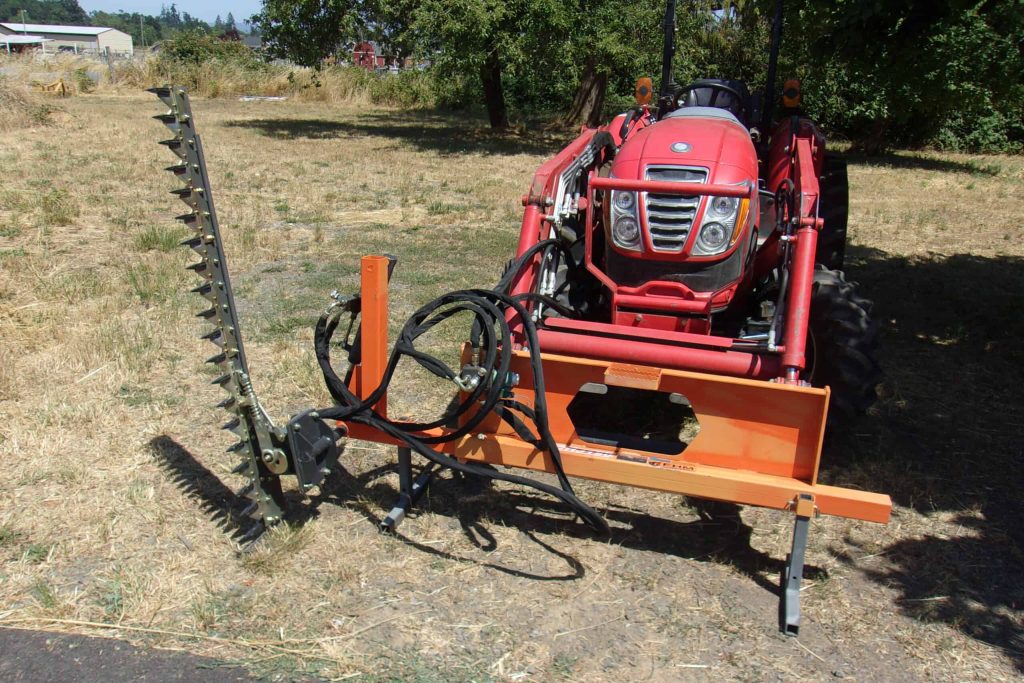
Conclusion
Hydraulic sickle bar mowers have become a preferred choice in modern agriculture and landscaping due to their efficiency, environmental benefits, user-friendly operation, and adaptability to various terrains. Regular maintenance and proper handling can significantly reduce the likelihood of equipment malfunctions and associated repair costs, thereby extending the machine’s operational lifespan. For novice operators, engaging in appropriate training and hands-on practice is essential to quickly acquire the necessary skills for safe and effective use. When selecting a hydraulic sickle bar mower and its complementary accessories, the MINNUO brand stands out for its exceptional quality and comprehensive after-sales support, making it a trustworthy choice for your equipment needs.

